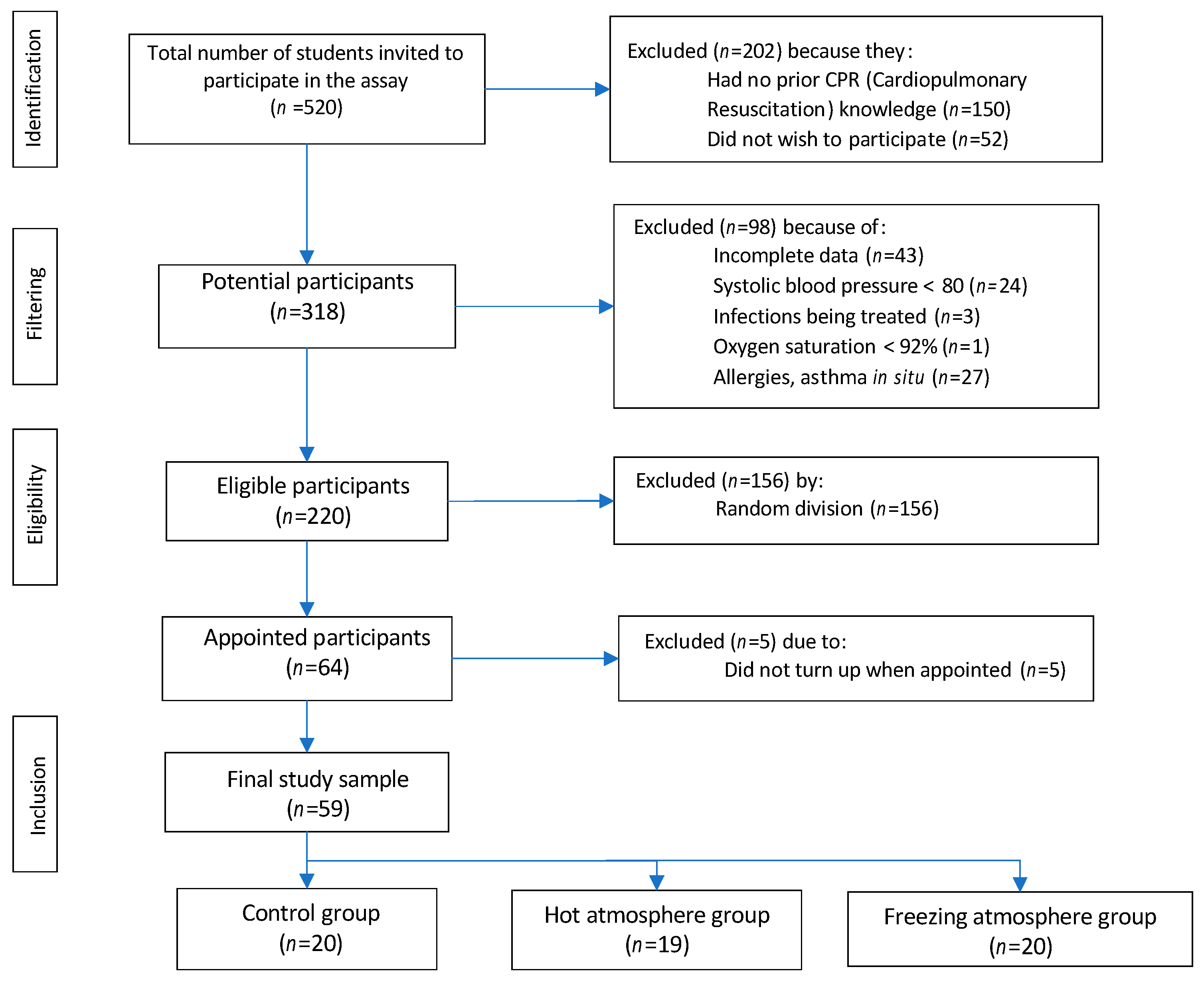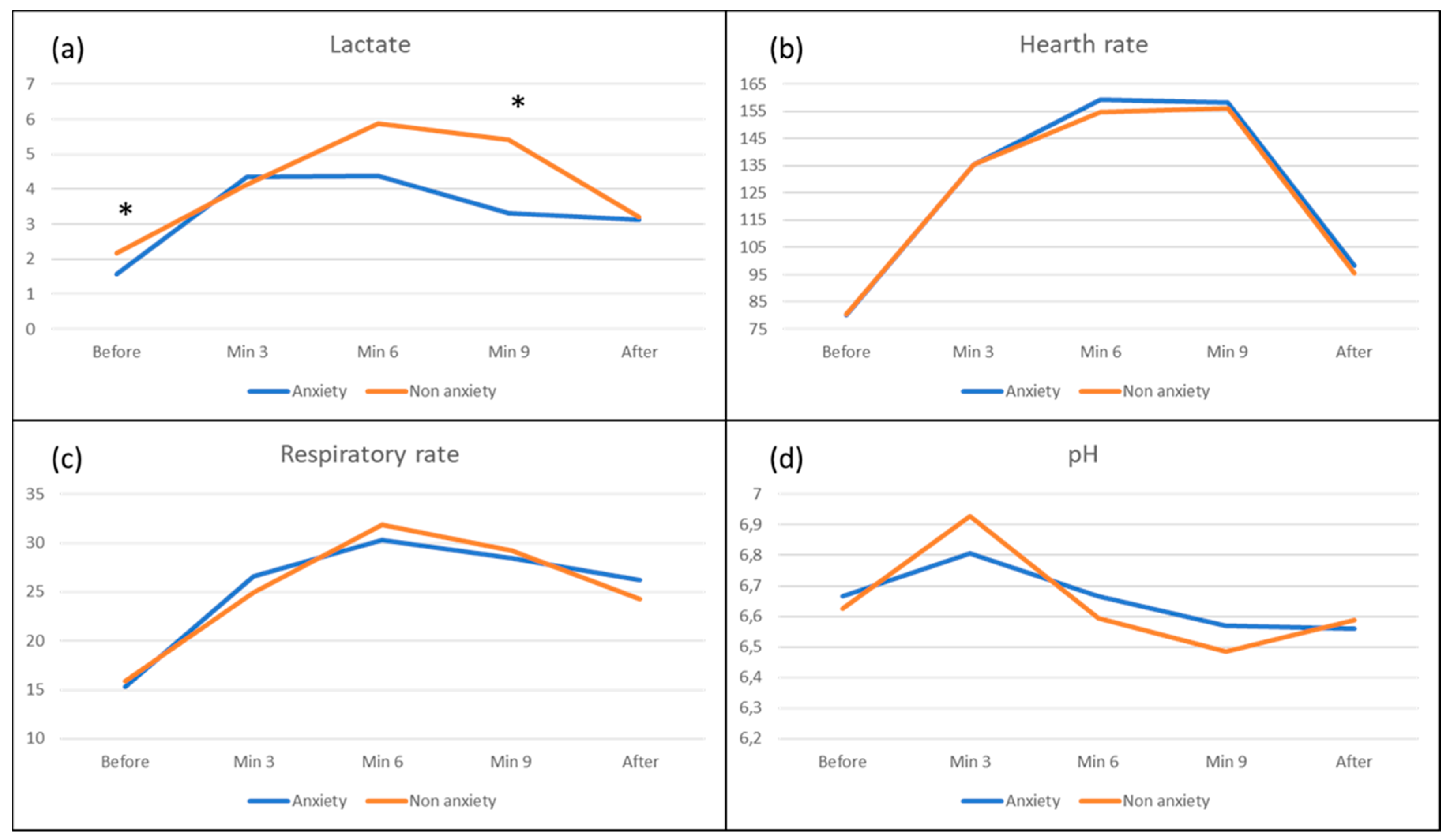Do Rescuers’ Physiological Responses and Anxiety Influence Quality Resuscitation under Extreme Temperatures?
Abstract
1. Introduction
2. Materials and Methods
2.1. Study Design
2.2. Population
2.3. Study Protocol
2.4. Data Analysis
3. Results
4. Discussion
5. Conclusions
Author Contributions
Funding
Acknowledgments
Conflicts of Interest
References
- Harder, N.; Stevenson, M.; Turner, S. Using simulation design characteristics in a non-manikin learning activity to teach priorization skills to undergraduate nursing students. Clin. Simul. Nurs. 2019, 36, 18–21. [Google Scholar] [CrossRef]
- Levett-Jones, T.; Pitt, V.; Courtney-Pratt, H.; Harbrow, G.; Rossiter, R. What are the primary concerns of nursing students as they prepare for and contemplate their first clinical placement experience? Nurse Educ. Pract. 2015, 15, 304–309. [Google Scholar] [CrossRef] [PubMed]
- Munroe, B.; Curtis, K.; Murphy, M.; Strachan, L.; Buckley, T. HIRAID: An evidence-informed emergency nursing assessment framework. Australas. Emerg. Nurs. J. 2015, 18, 83–97. [Google Scholar] [CrossRef] [PubMed]
- Ayuso-Murillo, D.; Colomer-Sánchez, A.; Herrera-Peco, I. Communication skills in ICU and adult hospitalisation unit nursing staff. Enferm. Intensiv. 2017, 28, 105–113. [Google Scholar] [CrossRef]
- Derrick, K.; Green, T.; Wand, T. Assessing and responding to anxiety and panic in the Emergency Department. Australas. Emerg. Care 2019, 22, 216–220. [Google Scholar] [CrossRef] [PubMed]
- Larsen, T.; Beier-Holgersen, R.; Østergaard, D.; Dieckmann, P. Training residents to lead emergency teams: A qualitative review of barriers, challenges and learning goals. Heliyon 2018, 4, e01037. [Google Scholar] [CrossRef]
- Cooper, J.; Barnett, M. Aspects of caring for dying patients which cause anxiety to first year student nurses. Int J. Palliat. Nurs. 2005, 11, 423–430. [Google Scholar] [CrossRef]
- Al-Ghareeb, A.; Cooper, S.; McKenna, L. Anxiety and clinical performance in simulated setting in undergraduate health professionals education: An integrative review. Clin. Simul. Nurs. 2017, 13, 478–491. [Google Scholar] [CrossRef]
- Khalaila, R. Simulation in nursing education: An evaluation of students’ outcomes at their first clinical practice combined with simulations. Nurse Educ. Today 2014, 34, 252–258. [Google Scholar] [CrossRef]
- Dearmon, V.; Graves, R.J.; Hayden, S.; Mulekar, M.S.; Lawrence, S.M.; Jones, L.; Farmer, J.E. Effectiveness of simulation-based orientation of baccalaureate nursing students preparing for their first clinical experience. J. Nurs. Educ. 2013, 52, 29–38. [Google Scholar] [CrossRef]
- Gunberg Ross, J.; Carney, H. The effect of formative capstone simulation scenarios on novice nursing students´ anxiety and self-confidence related to initial clinical practicum. Clin. Simul. Nurs. 2017, 13, 116–120. [Google Scholar] [CrossRef]
- Peplau, H.E. The psychiatric nurses’ family group. Am. J. Nurs. 1952, 52, 1475–1477. [Google Scholar] [CrossRef] [PubMed]
- Kilcoyne, M.; Dowling, M. Working in an overcrowded accident and emergency department: Nurses’ narratives. Aust. J. Adv. Nurs. 2007, 25, 21–27. [Google Scholar]
- Gilbertson, A.D. Sex bias in diagnosis. Hosp. Commu. Psych. 1992, 43, 406–407. [Google Scholar] [CrossRef] [PubMed]
- De Benedittis, G. Neural mechanisms of hypnosis and meditation. J. Physiol. Paris 2015, 109, 152–164. [Google Scholar] [CrossRef]
- Kenny, G.; Bray, I.; Pontin, D.; Jefferies, R.; Albarran, J. A randomized controlled trial of student nurse performance of cardiopulmonary resuscitation in a simulated family-witnessed resuscitation scenario. Nurse Educ. Pract. 2017, 24, 21–26. [Google Scholar] [CrossRef]
- Martín Rodríguez, F.; Fernández Pérez, C.; Castro Villamor, M.; Martín Conty, J.L.; Arnillas Gómez, P.; Casado Vicente, V. Does Level D Personal Protective Equipment Guard Against Hazardous Biologic Agents During Cardiopulmonary Resuscitation? Emergencias 2018, 30, 119–122. [Google Scholar]
- Spielberger, C.D.; Gorsuch, R.L.; Lushene, R.E. STAI Cuestionario de Ansiedad Estado-Rasgo, 6th ed.; TEA Ediciones: Madrid, Spain, 2002. [Google Scholar]
- Arráez-Aybar, L.A.; Castaño-Collado, G.; Casado-Morales, M.I. Dissection from the Spanish anatomist’s perspective: Aims, attitudes, and related aspects. Anat. Rec. 2004, 281, 15–20. [Google Scholar]
- Casado, M.I.; Castaño, G.; Arráez-Aybar, L.A. Audiovisual material as educational innovation strategy to reduce anxiety response in students of human anatomy. Adv. Health Sci. Educ. Theory Pract. 2012, 17, 431–440. [Google Scholar] [CrossRef]
- Fonseca-Pedrero, E.; Paino, M.; Sierra-Baigrie, S.; Lemos-Giráldez, S.; Muñiz, J. Propiedades psicométricas del “Cuestionario de Ansiedad Estado-Rasgo” (STAI) en Universitarios. Behav. Psychol. 2012, 20, 547–561. [Google Scholar]
- Beischel, K. Variables affecting learning in a simulation experience: A mixed methods study. West. J. Nurs. Res. 2013, 35, 226–247. [Google Scholar] [CrossRef] [PubMed]
- Keitel, A.; Ringleb, M.; Schwartges, L.; Weik, U.; Picker, O.; Stockhoprst, U.; Deinzer, R. Endocrine and psychological stress responses in a simulated emergency situation. Psychoneuroendocrinology 2011, 36, 98–108. [Google Scholar] [CrossRef] [PubMed]
- Niemi-Murola, L.; Mäkinen, M.; Castren, M. Medical and nursing students´ attitudes toward cardiopulmonary resucitation and current practice guidelines. Resucitation 2007, 72, 257–263. [Google Scholar] [CrossRef] [PubMed]
- Girzadas, D.; Delis, S.; Bose, S.; Hall, J.; Rzechula, K.; Kulstad, E. Measures of stress and learning seem to be equally affected among all roles in a simulation scenario. Simul. Healthc. 2009, 4, 149–154. [Google Scholar] [CrossRef]
- Mills, B.; Carter, O.; Rudd, C.; Claxton, L.; Ross, N.; Strobel, N. Effects of low-versus high-fidelity simulations on the cognitive burden and performance of entry-level paramedicine students. Soc. Simul. Healthc. 2016, 11, 10–18. [Google Scholar] [CrossRef]
- Fernández-Ayuso, D.; Fernández-Ayuso, R.; Del-Campo-Cazallas, C.; Pérez-Olmo, J.L.; Matías-Pompa, B.; Fernández-Carnero, J.; Calvo-Lobo, C. The Modification of Vital Signs According to Nursing Students’ Experiences Undergoing Cardiopulmonary Resuscitation Training via High-Fidelity Simulation: Quasi-Experimental Study. Jmir. Serious Games 2018, 6, e11061. [Google Scholar] [CrossRef]
- Hermann, R.; Lay, D.; Wahl, P.; Roth, W.T.; Petrowski, K. Effects of psychosocial and physical stress on lactate and anxiety levels. Stress 2019, 22, 664–669. [Google Scholar] [CrossRef]
- Grossbard, J.R.; Smith, R.E.; Smoll, F.L.; Cumming, S.P. Competitive anxiety in young athletes: Differentiating somatic anxiety, worry, and concentration disruption. Anxiety Stress Coping 2009, 22, 153–166. [Google Scholar]
- Tanguy, G.; Sagui, E.; Fabien, Z.; Martin-Krumm, C.; Canini, F.; Trousselard, M. Anxiety and Psycho-Physiological Stress Response to Competitive Sport Exercise. Front. Psychol. 2018, 9, 1469. [Google Scholar] [CrossRef]
- González Campos, G.; Valdivia-Moral, P.; Cachón Zagalaz, J.; Zurita Ortega, F.; Romero-Ramos, O. Influence of stress control in the sports performance: Self-confidence, anxiety and concentration in athletes. Retos 2017, 32, 3–6. [Google Scholar]
- Fernández-Castillo, A.; Caurcel, M.J. State test-anxiety, selective attention and concentration in university students. Int. J. Psychol. 2015, 50, 265–271. [Google Scholar]
- De Maria, S.; O. Bryson, E.; Mooney, T.J.; Silverstein, J.H.; Reich, D.L.; Bodian, C.; Levine, A.I. Adding emotional stressors to training in simulated cardiopulmonary arrest enhances participant performance. Med. Educ. 2010, 44, 1006–1015. [Google Scholar] [CrossRef] [PubMed]
- Fernández-Aedo, I.; Pérez-Urdiales, I.; Unanue-Arza, S.; García-Azpiazu, Z.; Ballesteros-Peña, S. A qualitative study about experiences and emotions of emergency medical technicians and out-of-hospital emergency nurses after performing cardiopulmonary resuscitation resulting in death. Enferm. Intensiv. 2017, 28, 57–63. [Google Scholar]
- Vos, H.M.; Louw, D.A. The Effect of Hypnotic Training Programs on the Academic Performance of Students. Am. J. Clin. Hypn. 2006, 49, 101–112. [Google Scholar] [CrossRef] [PubMed]
- Kirsch, I.; Montgomery, G.; Sapirstein, G. Hypnosis as an adjunct to cognitive-behavioral psychotherapy: A meta-analysis. J. Consult. Clin. Psychol. 1995, 63, 214–220. [Google Scholar] [CrossRef]
- Mendoza, M.E.; Capafons, A. Valencia Model of Waking Hypnosis: Background, Research, and Clinical Applications. Am. J. Clin. Hypn. 2018, 61, 108–124. [Google Scholar] [CrossRef]
- Hafferty, F.W. Beyond curriculum reform: Confronting medicine’s hidden curriculum. Acad. Med. 1998, 73, 403–407. [Google Scholar] [CrossRef]
- Rizzolo, L.J. Human dissection: An approach to interweaving the traditional and humanistic goals of medical education. Anat. Rec. 2002, 269, 242–248. [Google Scholar] [CrossRef]
- Wagoner, N.E.; Romero-O`Connell, J.M. Privileged learning. Anat. Sci. Educ. 2009, 2, 47–48. [Google Scholar] [CrossRef]
- Lazarus, L.; Sookrajh, R.; Satyapal, K.S. Reflective journals: Unmasking student perceptions of anatomical education. Folia Morphol. (Warsz) 2017, 76, 506–518. [Google Scholar] [CrossRef]



| Variables | Male | Female | p Value Sex | ||
|---|---|---|---|---|---|
| n | Mean ± SD | n | Mean ± SD | ||
| Age | 27 | 21.5 ± 2.76 | 32 | 21.2 ± 2.83 | 0.648 |
| Trait STAI | 25 | 18.7 ± 9.69 | 27 | 22.3 ± 10.52 | 0.214 |
| State STAI before | 27 | 12.6 ± 9.16 | 28 | 16.7 ± 9.81 | 0.120 |
| State STAI after | 26 | 16.9 ± 8.20 | 30 | 14.0 ± 7.62 | 0.173 |
| p value State STAI before/after | 0.068 | 0.245 | |||
| Total STAI before | 25 | 8.7 ± 8.27 | 26 | 12.0 ± 9.54 | 0.187 |
| Total STAI after | 25 | 6.4 ± 5.55 | 27 | 10.4 ± 7.89 | 0.039 * |
| p value Total STAI before/after | 0.181 | 0.401 | |||
| STAI Variables | Control | Experimental Group | Total | p Value | ||||||
|---|---|---|---|---|---|---|---|---|---|---|
| Heat Group | Cold Group | |||||||||
| n | Mean ± SD | n | Mean ± SD | n | Mean ± SD | n | Mean ± SD | |||
| Trait STAI | 16 | 25.7 ± 11.19 | 16 | 16.0 ± 7.60 | 20 | 20.1 ± 9.68 | 52 | 20.6 ± 10.19 | 0.022 * | |
| State STAI before | 16 | 9.7 ± 8.94 | 19 | 13.9 ± 8.01 | 20 | 19.4 ± 9.74 | 55 | 14.7 ± 9.63 | 0.008 * | |
| State STAI after | 18 | 17.0 ± 8.65 | 18 | 12.1 ± 8.33 | 20 | 16.7 ± 6.28 | 56 | 15.3 ± 7.96 | 0.108 | |
| p value State STAI before/after | 0.005 * | 0.364 | 0.285 | 0.666 | ||||||
| Total STAI before | 15 | 19.8 ± 9.23 | 16 | 5.4 ± 5.16 | 20 | 7.4 ± 5.49 | 51 | 10.4 ± 9.01 | 0.000 * | |
| Total STAI after | 16 | 11.5 ± 6.89 | 16 | 6.6 ± 7.02 | 20 | 7.6 ± 6.88 | 52 | 8.5 ± 7.10 | 0.116 | |
| p value Total STAI before/after | 0.008 * | 0.446 | 0.905 | 0.122 | ||||||
| STAI Before | Anxiety | Non-Anxiety | p Value | ||
|---|---|---|---|---|---|
| n | Mean ± SD | n | Mean ± SD | ||
| Lactate before | 17 | 1.46 ± 0.68 | 34 | 2.16 ± 1.24 | 0.012 * |
| Hearth rate before | 17 | 74.71 ± 11.30 | 34 | 83.18 ± 15.02 | 0.030 * |
| Respiratory rate before | 17 | 14.59 ± 2.74 | 34 | 16.32 ± 5.06 | 0.119 |
| Temperature before | 17 | 36.59 ± 0.48 | 34 | 36.75 ± 0.35 | 0.181 |
| pH before | 17 | 6.72 ± 0.40 | 34 | 6.66 ± 0.58 | 0.716 |
© 2020 by the authors. Licensee MDPI, Basel, Switzerland. This article is an open access article distributed under the terms and conditions of the Creative Commons Attribution (CC BY) license (http://creativecommons.org/licenses/by/4.0/).
Share and Cite
Martin-Conty, J.L.; Martin-Rodríguez, F.; Criado-Álvarez, J.J.; Romo Barrientos, C.; Maestre-Miquel, C.; Viñuela, A.; Polonio-López, B.; Durantez-Fernández, C.; Marcos-Tejedor, F.; Mohedano-Moriano, A. Do Rescuers’ Physiological Responses and Anxiety Influence Quality Resuscitation under Extreme Temperatures? Int. J. Environ. Res. Public Health 2020, 17, 4241. https://doi.org/10.3390/ijerph17124241
Martin-Conty JL, Martin-Rodríguez F, Criado-Álvarez JJ, Romo Barrientos C, Maestre-Miquel C, Viñuela A, Polonio-López B, Durantez-Fernández C, Marcos-Tejedor F, Mohedano-Moriano A. Do Rescuers’ Physiological Responses and Anxiety Influence Quality Resuscitation under Extreme Temperatures? International Journal of Environmental Research and Public Health. 2020; 17(12):4241. https://doi.org/10.3390/ijerph17124241
Chicago/Turabian StyleMartin-Conty, José Luis, Francisco Martin-Rodríguez, Juan José Criado-Álvarez, Carmen Romo Barrientos, Clara Maestre-Miquel, Antonio Viñuela, Begoña Polonio-López, Carlos Durantez-Fernández, Félix Marcos-Tejedor, and Alicia Mohedano-Moriano. 2020. "Do Rescuers’ Physiological Responses and Anxiety Influence Quality Resuscitation under Extreme Temperatures?" International Journal of Environmental Research and Public Health 17, no. 12: 4241. https://doi.org/10.3390/ijerph17124241
APA StyleMartin-Conty, J. L., Martin-Rodríguez, F., Criado-Álvarez, J. J., Romo Barrientos, C., Maestre-Miquel, C., Viñuela, A., Polonio-López, B., Durantez-Fernández, C., Marcos-Tejedor, F., & Mohedano-Moriano, A. (2020). Do Rescuers’ Physiological Responses and Anxiety Influence Quality Resuscitation under Extreme Temperatures? International Journal of Environmental Research and Public Health, 17(12), 4241. https://doi.org/10.3390/ijerph17124241









